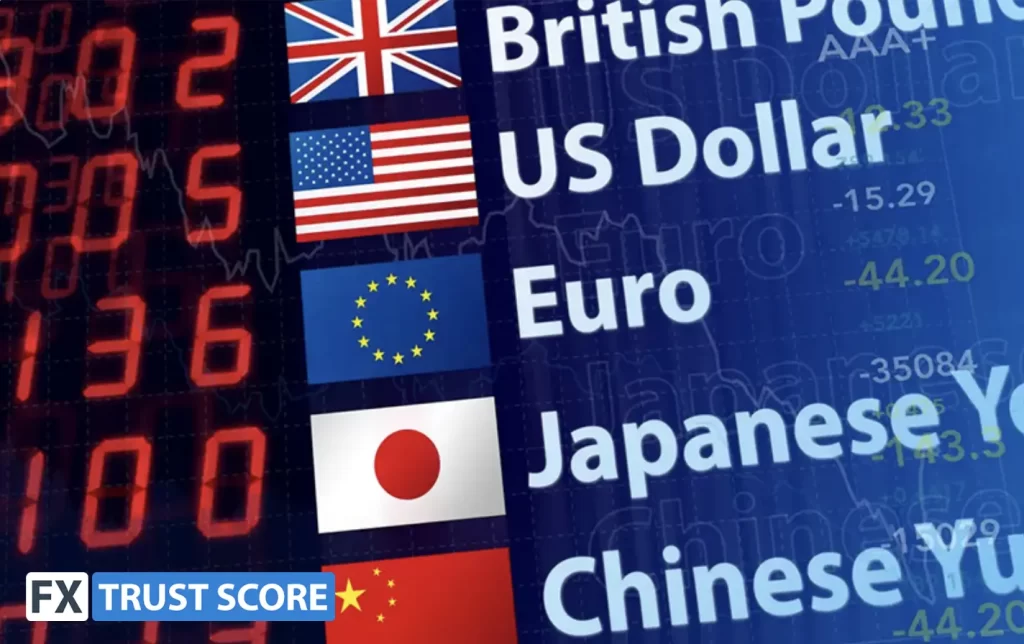
Currency trading, also referred to as forex trading, is the largest financial market in the world, with millions of traders exchanging different FX currencies 24 hours a day, 5 days a week. It’s a hugely popular activity, being easily accessible for everyone – from the largest banking institution to an individual exchanging their holiday money.
Forming the backbone of the entire global financial system, forex currency trading plays such an important part of everyday life. It’s a topic that needs no introduction for some, but we have put together all the key things you should know about, including some points which are often overlooked by many of those who trade forex.
An Overview of Currency Trading
In simple terms, currency trading is the buying and selling of one currency in exchange for another through FX pairs like EUR/USD and USD/JPY. While the fundamental process of foreign exchange is essentially the same, it can take various forms.
For example, a professional foreign exchange trader will be looking to profit from changes in value between currencies. Compare this to your average tourist, who may just be exchanging their usual currency in order to have spending money on their holiday.
Aside from individual transactions, different currencies can also change hands on a much larger scale], whether it is through governments managing their foreign reserves, central banks intervening to stabilise their national currencies, or large multinational corporations converting profits across from their global operations.
Currency Pairs and Pips
Within the world of trading, you may have noticed that terms like ‘currency pairs’ and ‘pips’ are frequently mentioned by brokers and traders – but what exactly do they mean?
Currency Pairs
Let’s start with currency pairs. They represent the value of one currency against another and are displayed together as a pair like EUR/USD, GBP/JPY, or GBP/EUR. In this format, the currency appearing first is known as the ‘base’ currency and the second is called the ‘quote’ currency.
Going a little deeper into it, there are three distinct groups of currency pairs: majors, minors, and exotics. Major currency pairs are the most traded, matching popular global currencies like the euro, British pound, and Japanese yen with the US dollar. Popular major pairs include EUR/USD, USD/JPY, and GBP/USD.
As for minors, these are currency pairs that don’t include the US dollar but include other major currencies paired with each other, such as EUR/GBP, GBP/JPY, and EUR/AUD. Exotics are made up of a major currency paired with a smaller currency from an emerging economy, like USD/TRY (Turkish lira) or EUR/SEK (Swedish krona).
Pips
Now, let’s talk about pips. In forex, a pip is the smallest unit of price change in a currency pair, generally represented by the fourth decimal place. To take a practical example, when EUR/USD shifts from 1.0810 to 1.0811, it reflects a one-pip change.
Pips provide a standard measure of exchange rate movements, playing an important role in a trader’s risk management and trading strategy. Traders can use them to track market moves in real time and quickly manage potential gains or losses, such as through setting stop-loss and take-profit orders.
What are the Most Traded Currency Pairs?
EUR/USD
The world’s most traded currency pair, EUR/USD represents the two largest western economies: the eurozone (euro) and the United States (US dollar). In US English, it’s nicknamed the ‘Fiber’ in reference to both the special fibres in euro banknotes and the high-speed fibre-optic cables that link financial hubs in Europe and the U.S.
USD/JPY
This pair features the US dollar and Japanese yen and is commonly known by two distinct nicknames. Its primary nickname is ‘Ninja’ which reflects both Japan’s cultural icon and the pair’s often volatile, swift movements. Occasionally, traders also refer to USD/JPY as the ‘Gopher’ though the origins of this nickname are less clear.
GBP/USD
Another hugely popular pair, this time involving the British pound and the US dollar. Famously referred to as the ‘Cable’, it’s nickname is thought to originate from the 19th century transatlantic telegraph cable which linked Great Britain and the United States, immortalising the historic connection between the two nations.
USD/CNY
This is a significant pair as it’s made up of currencies from the world’s two largest and most prosperous economies, comprising the US Dollar (United States) and the Chinese yuan (China), also known as the Renminbi. While it doesn’t have a nickname given to it, many people refer to it as the ‘Yuan Dollar’.
USD/CAD
This US dollar and Canadian dollar pairing signifies the strong economic connection between these neighbouring North American nations. Known as the ‘Loonie,’ its nickname derives from the loon bird featured on Canada’s iconic one-dollar coin, symbolising both countries’ shared heritage and the pair’s market significance.
AUD/USD
Representing the connection between the Australian and US economies, the AUD/USD, or ‘Aussie,’ is an important currency pair in global trading. It’s heavily influenced by Australia’s key exports, including metals and minerals, and offers up a snapshot of economic conditions and market sentiment across both countries.
What are Direct and Indirect Currency Quotes?
In currency trading, direct and indirect quotes refer to two different ways of showing the currency exchange rate between two countries. Put simply, a direct quote tells you how much one unit of a foreign currency would cost in terms of your local currency, whereas an indirect quote shows how much foreign currency you can get for one unit of your local currency.
Let’s break things down using examples:
Scenario 1: If you’re in the UK and you come across an exchange rate shown as ‘GBP/USD 1.30,’ it means that it’s a direct quote for British traders. Therefore, every 1 British pound (GBP) is worth 1.30 US dollars (USD). In other words, if you have 1 GBP, you would receive 1.30 USD.
Scenario 2: If you’re in the UK and you see an exchange rate listed as ‘USD/GBP 0.77,’ it means that it’s an indirect quote for British traders. So in this case, every 1 US dollar (USD) has a value of 0.77 British pounds (GBP). In other words, if you have 1 USD, you would receive 0.77 GBP.
Factors which can Influence Currency Prices
As anyone knows, currency prices don’t just stay the same, they are constantly fluctuating. Exchange rates regularly move up and down depending on a mix of different factors, which can be broadly categorised as economic shifts, political shifts, and market sentiment.
Currency movements can vary in terms of their size and impact, presenting traders with opportunities to make gains or losses based on the scale and significance of each shift. With that in mind, let’s take a look at some of the most important examples of factors which affect currency prices.
Economic Market Data of Large Countries
Currencies are sensitive to the performance of the world’s largest economies, such as the US, China, Japan, and the eurozone, which between them account for a significant portion of global GDP. These regions are major players in international trade, meaning that changes in their economic conditions affect trade flows and demand for currencies.
Currencies are also typically affected by key indicators like GDP growth, employment numbers, manufacturing activity, and consumer spending. Positive data tends to boost investor confidence, leading to currency appreciation, while weaker data often results in price depreciation.
Traders closely monitor these economic releases, as they provide insights into potential currency shifts and can impact trading decisions across global markets. You can track the most important upcoming economic data releases via our regular ‘Weekly Market Preview’ articles, which you’ll find in our Market News section.
Geopolitical Tensions
During times of heightened geopolitical uncertainty, forex currencies are more likely to experience significant price movements, particularly when there are tensions at play. Prime examples of this include military conflicts, trade disputes, and political regime instability.
Each of these scenarios drive currency volatility, with rising tensions usually leading to weakened currencies in the affected regions. Military conflicts can trigger ‘capital flight,’ whereby funds or assets are transferred out of a country. As for trade disputes, these tend to disrupt economic activity and trade balances, while political instability can lead to traders withdrawing from currencies that are impacted the most.
Due to the fast moving nature of how geopolitical events develop, markets can shift very quickly, which can have an unexpected impact on currency prices. This makes it essential that traders keep well informed by tracking the latest news and analysis to better anticipate potential market reactions and adjust their strategies accordingly.
Central Bank Decision Making
The actions of the world’s largest central banks can have a major impact on currency values, with the most influential ones representing leading global economies like the United States (Federal Reserve), eurozone (European Central Bank), and Japan (Bank of Japan). Here, their decisions not only affect their own currencies (USD, EUR, JPY) but also influence currency values worldwide.
Often the markets hang on the every word of key figures within these institutions, whether it’s through meeting minutes or even unguarded personal remarks. However, it’s the actual policy decisions that have the most dramatic effect on currencies. For example, when central banks set interest rates or adjust monetary policies, they are having a direct influence on the supply and demand for their currencies.
It’s so important to keep a close eye on the latest central bank announcements because unexpected policy shifts can lead to sudden, unexpected price swings and increased market volatility. Make sure that you keep up-to-date with the most important scheduled central bank meetings and upcoming data releases via our Economic Calendar and stay one step ahead of what could be set to move the currency markets
Tracking Performance with Currency Charts
Currency charts offer a useful way to track price performance and identify key trends in the forex market. Across a range of different time frames, they allow traders to closely analyse historical price data, discover clear patterns, and anticipate potential future price movements. These charts display different sets of data, each offering their own unique insights to traders.
They come in various different formats, with the most popular and established ones being line, bar, and candlestick charts. Technical indicators, like moving averages and RSI, are also applied to charts to enhance analysis. Understanding how to effectively interpret currency charts is a key tool in the armour of any trader, playing a crucial role when it comes making informed, strategic, and well-timed trading decisions.
Where Investors Can Trade Forex Currencies
Forex trading primarily takes place on the global forex market, a vast and decentralised network which is accessible to traders through online trading platforms and forex brokers. Investors are able to trade forex via major global financial hubs like London, New York, Tokyo, and Sydney, which operate 24 hours a day during the trading week.
The best forex brokers provide quick and easy access to these markets, allowing investors to trade a wide variety of currency pairs through their trading platforms. Thanks to its low transaction costs, high liquidity, and accessibility from almost any location, the forex market continues to hold the title of the largest and most liquid financial market in the world.
We hope you enjoyed reading this overview guide about currency trading. If you’re looking to take your trading knowledge to the next level, feel free to check out our informative article about leverage in forex trading.
Publication date:
01/11/2024
Author: FX Trust Score
Last updated on March 28, 2025



